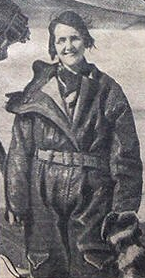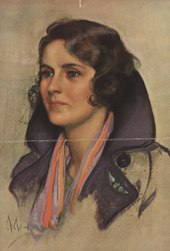Ruth Rowland Nichols
Ruth Rowland Nichols (born February 23, 1901 in New York City , † September 25, 1960 there ) was an American aviation pioneer . To this day she is the only woman who simultaneously held world records for speed, altitude and distance covered.
biography
Nichols was the daughter of Erickson Norman Nichols and Edith Corlis Haines. Her father was a member of the New York Stock Exchange and was previously a member of Theodore Roosevelt's Rough Riders . Ruth Nichols was sent by her parents to the Masters School , which was originally organized as an all-girls school and has only been accepting boys since 1996. To her high school Accounts 1919 her father gave her a flight at Stinson Aircraft Company with Edward Anderson "Eddie" Stinson, Jr., a flying ace of the First World War , which woke up the career aspirations in her to become a pilot. After graduating from school, however, she first attended Wellesley College , where she studied medicine, where she graduated in 1924.
Career as a pilot
As a college student, Nichols secretly took flying lessons. Shortly after graduating from college, she received her flight license and, at the same time, became the first woman in the world to receive a license for a hydroplane . She first became known to the public when she operated the first non-stop flight from New York City to Miami in January 1928 as co-pilot of her former flight instructor Harry Rogers . Due to their very social upbringing and her aristocratic family background Nichols was in the press as the Flying Debutante , the flying debutante called what you did not like. She then worked as a sales manager at Fairchild Aviation Corporation and in 1929 founded the Ninety Nines , an organization by and for licensed female pilots, together with Amelia Earhart and other women .
In the 1930s, Nichols set a number of flight records. In 1930 she broke the record time held by Charles Lindbergh for the first time for a flight from the east to the west coast of the USA, which she finished after 13 hours and 21 minutes. In March 1931, she flew to an altitude of 28,743 feet (8,760.9 meters), higher than any woman before. In April 1931, she increased the women's world speed record to 210.7 miles per hour (339.1 km / h). In June 1931, when she attempted to become the first woman to cross the Atlantic alone , she crashed in New Brunswick , sustaining serious injuries. After recovering, she was able to increase the women's world distance record to 1,977 miles (3,182 km) by flying non-stop from Oakland , California to Louisville , Kentucky .
On February 14, 1932, Nichols scored a Lockheed Vega at Floyd Bennett Field in New York and set a new world altitude record for diesel-powered aircraft at 19,928 feet. On December 29th of the same year she became the first female pilot for the commercial passenger airline New York and New England Airways.
On October 21, 1935, she was critically injured when she fell during an aerobatic flight in Troy . She couldn't fly for almost a year. After her return to aviation, Nichols worked for the Emergency Peace Campaign, a Quaker organization aimed at promoting a peaceful solution to international conflicts that were simmering at the time. In 1939 she was head of the Relief Wings, a civil aviation service that mainly carried out emergency rescue flights and assisted the Civil Air Patrol during World War II . Nichols rose to the rank of Lieutenant Colonel in the Civil Air Patrol .
After the war, Nichols used her notoriety to point out the causes of various humanitarian emergencies and to collect donations. So she organized a mission to support UNICEF and flew around the world once in 1949. In the 1950s she served as the director of women's activities at Save the Children , headed the women's division at the United Hospital Fund, and was field director for the National Nephrosis Foundation.
After long campaigning for a permit with the United States Air Force , she was allowed to fly a Convair F-102 as copilot in 1958 and reached a speed of 1,000 miles per hour (1,600 km / h) and an altitude of 51,000 feet ( 15,545 m). With this she set a new women's world record for speed and height at the age of 57.
Women in the space program
When the American NASA prepared the missions to land on the moon in 1959, Nichols underwent the same tests in the centrifuge as well as for isolation and weightlessness that had been designed for the astronaut applicants . The tests were conducted at the Wright Air Development Center in Dayton , Ohio by Donald Flickinger, then a Brigadier General of the United States Air Force . Flickinger and his mentor Randy Lovelace , who carried out the medical selection of the members of the Mercury Seven , had an extensive interest in researching the suitability of women for the astronaut profession, but no official document exists that could give a reason for this.
Although Nichols, unlike her female counterparts (the Mercury 13 ), did not pass all Phase 1 tests, her performance was nonetheless good enough to convince the Air Force scientists to include women in the space program. However, the scientists at the Wright Development Center were reluctant and passed the test results to the press, which, with correspondingly negative headlines, stopped the Air Force funding for female astronaut applicants. In the end, Jerrie Cobb alone was able to complete all three test phases before NASA stopped the program.
End of her career
Nichols suffered from severe depression and was found dead in her New York City apartment in 1960. The cause of death was an overdose of barbiturates . Her remains are in Woodlawn Cemetery in New York's Bronx .
During her career, Nichols has flown every newly developed type of aircraft, including zeppelins , gliders , gyroscopes , seaplanes , biplanes , triplane , transport planes and even supersonic jets and was posthumously inducted into the National Aviation Hall of Fame in 1992. A propeller her Lockheed Vega from 1930 is in the National Air and Space Museum in the section Golden Age of Flight (dt. The golden age of aviation issued).
Individual evidence
- ^ Century of Flight: The Women Who Dared the Skies. Retrieved September 2, 2011 .
- ^ Stephanie Nolen: Promised the moon . the untold story of the first women in the space race. Four Walls Eight Windows, New York 2003, ISBN 978-1-56858-275-7 (English).
literature
- Roger D. Launius: Nichols, Ruth Rowland . In: American National Biography Online 2000.
Web links
- Mur Wolf: Ruth Nichols . In: Wellesley College - Person of the Week . Retrieved August 28, 2006.
- D. Cochrane and P. Ramirez: Ruth Nichols . In: National Air and Space Museum, Smithsonian Institution . Retrieved August 28, 2006.
- Jone Johnson Lewis: Ruth Nichols . In: Women's History . Retrieved August 28, 2006.
| personal data | |
|---|---|
| SURNAME | Nichols, Ruth Rowland |
| ALTERNATIVE NAMES | Nichols, Ruth |
| BRIEF DESCRIPTION | American aviation pioneer |
| DATE OF BIRTH | February 23, 1901 |
| PLACE OF BIRTH | new York |
| DATE OF DEATH | September 25, 1960 |
| Place of death | new York |

